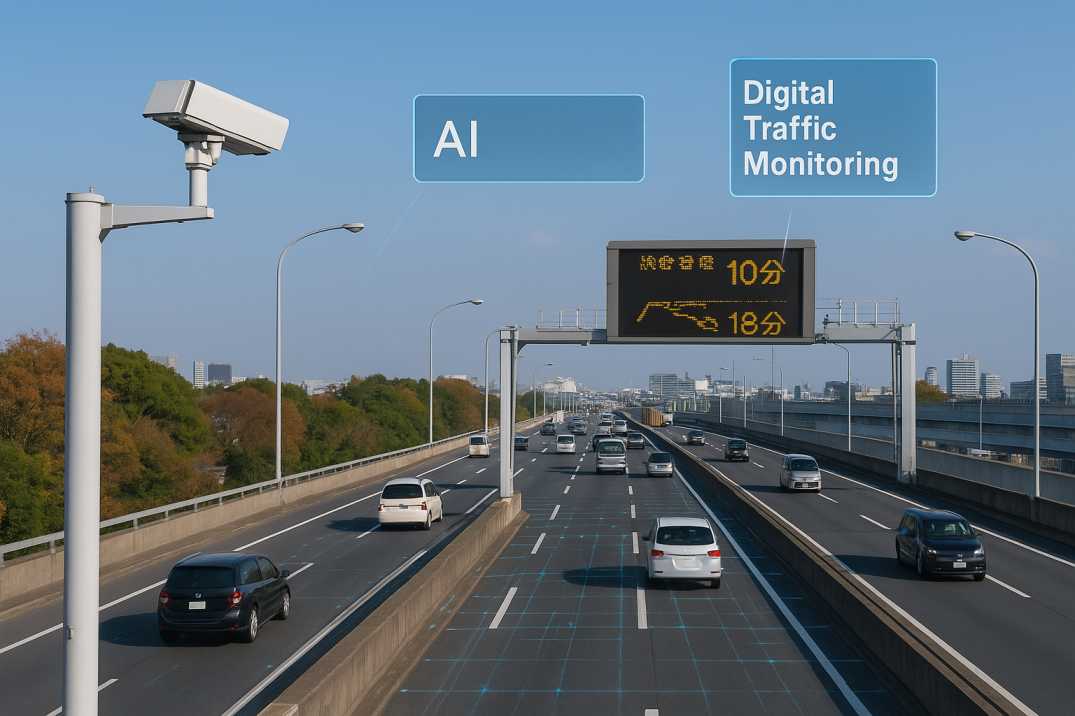Contact Us
RoadVision AI
Private Limited
Office No. 308 & 310, B Block
Ansal Chamber - 1, Bhikaji Cama Place,
Near Engineers India Limited (EIL) Bhawan, New Delhi - 110066
© 2024 | RoadVision AI | All rights reserved
Japan is globally recognized for its advanced infrastructure, reliable transport systems, and efficient toll road operations. With nearly 8,000 kilometers of expressways connecting major cities, toll road management has been central to Japan’s economic growth. However, increasing traffic volumes, aging infrastructure, and the need for real-time monitoring have prompted authorities to adopt AI-driven solutions.
By combining road asset management Japan, digital traffic monitoring systems, AI toll monitoring Japan, and intelligent transport systems Japan, the country is setting new benchmarks in highway automation and congestion-free travel.

Traditionally, toll management depended on manual collection systems and semi-automated Electronic Toll Collection (ETC). While these methods improved efficiency, they were still limited in predictive capabilities.
Today, AI-based toll monitoring in Japan leverages high-resolution cameras, machine learning, and real-time digital traffic monitoring to automatically detect congestion, track vehicle patterns, and optimize toll pricing models. This ensures smoother journeys while reducing bottlenecks.
Effective road asset management Japan is a national priority. Japan’s expressways face challenges of aging pavements, seismic risks, and high maintenance costs. To overcome this, agencies are using pavement condition surveys powered by AI.
These surveys generate accurate, real-time data on cracks, potholes, and structural deterioration, allowing agencies to predict failures before they occur. This proactive maintenance saves millions in repair costs while ensuring safety.
Japan has introduced digital traffic monitoring systems on its busiest corridors, including the Tomei Expressway and Metropolitan Expressway. These systems combine IoT sensors, AI-based cameras, and data integration platforms to create a digital twin of road conditions.
Such innovation not only improves traffic flow but also supports road safety audits that identify accident-prone zones and recommend design improvements.
The deployment of AI-based toll monitoring has eliminated traditional bottlenecks at toll plazas. Cameras equipped with AI traffic survey tools automatically capture license plates, calculate tolls, and enable seamless transactions without stopping vehicles.
This integration is also aligned with traffic surveys that track vehicle density, traffic mix, and travel time in real time, ensuring more effective congestion management through AI.
The Japanese government has been a pioneer in intelligent transport systems Japan. Projects such as the Smartway initiative integrate vehicle-to-infrastructure communication, smart navigation, and highway automation tools to minimize accidents and improve efficiency.
Data from road inventory inspections is combined with AI to enhance monitoring of expressways, ensuring each stretch is maintained to global safety standards.
Several expressways in Japan have already implemented AI-based digital traffic monitoring. For example, the Central Nippon Expressway Company has piloted predictive analytics systems that use AI to forecast congestion hours and dynamically adjust toll pricing.
Insights from such projects are often highlighted in global infrastructure forums, much like case studies showcasing the impact of AI in road management across the world.
With increasing adoption of digital traffic surveys, AI-based toll monitoring, and highway automation, Japan’s road sector is transitioning towards a completely digital ecosystem. This transformation is expected to reduce congestion by up to 30 percent, cut maintenance costs, and enhance driver safety.
The move towards smart highways Japan is not just about efficiency but about creating a sustainable model of infrastructure management that can serve as a global benchmark.
Japan’s approach to AI-driven toll road management demonstrates how advanced technologies can revolutionize road operations. By integrating road asset management Japan, digital traffic monitoring systems, and intelligent transport systems Japan, the country is successfully addressing congestion, safety, and sustainability challenges.
RoadVision AI is revolutionizing roads and transforming infrastructure development and maintenance with its innovative solutions in AI in roads. By leveraging Artificial Intelligence, digital twin technology, and advanced computer vision, the platform conducts thorough road safety audits, ensuring the early detection of potholes and other surface issues for timely repairs and improved road conditions. The integration of pothole detection and data-driven insights through AI also enhances traffic surveys, addressing congestion and optimizing road usage. Focused on creating smarter roads, RoadVision AI ensures compliance with IRC Codes as well as Japanese road regulations and highway standards, empowering engineers and stakeholders to reduce costs, minimize risks, and elevate road safety and transportation efficiency.
For organizations and governments aiming to replicate these solutions, AI-based tools provide a proven framework.
To explore how these solutions can be deployed in your region, book a demo with us.
1. How is AI used in toll road management in Japan?
AI is used to automate toll collection, monitor traffic, predict congestion, and optimize maintenance schedules.
2. What role does intelligent transport systems Japan play in highways?
They integrate AI, IoT, and automation to improve road safety, reduce congestion, and enhance travel efficiency.
3. Can AI reduce road maintenance costs in Japan?
Yes, predictive analytics from pavement condition surveys help identify issues early, reducing long-term repair expenses.